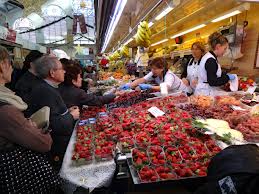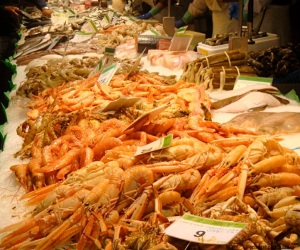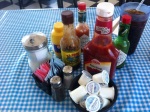You would not expect a child to grow to appreciate art without supplying her with a good box of crayons spanning the colours of the rainbow and beyond. Nor without taking her for regular walks where you may marvel at the shape of a tree, the light in the sky, the translucence shine of a stream or the expressiveness of a face. In years to come, as the child grows, you will take her to galleries and museums and point at how the masters move you to a deeper enjoyment of the world.
Yet we expect children to appreciate food without bothering to expand their horizons beyond the hastily perused shelves of a local supermarket. My experience of food in childhood, thankfully, was far richer than most thanks to a culture that still had the market at its heart and a mother who had her daughter at hers. On a Saturday morning my mother used to take me to the market: she would trail her shopping trolley (her carrito) behind her with her right hand, I would hold on to her left and an hour or so before the afternoon we would walk the fifteen minutes to the indoor market in my quarter: a mini labyrinth of stalls manned by rambunctious men and matronly women wearing blue aprons and coats.
In the market my nose would almost brush the cloudy surface of purple grapes piled on crates in September; in November, the pomegranate would shine with its leathery blush promising a bowl full of sugary rubies garnered by my mother; the spring would bring the promise of strawberries and cream. A child in Spain is always feted and I would invariably be handed a cherry stem or a fig by a kindly fruit seller. This blog is called a fistful of olives in celebration of the offerings of dry good sellers on market days, who would scoop their olives in their marinade out of wooden barrels, handing a few to young helpers like myself out with their mothers. The early exposure to the complexity of flavour and texture of the olive –bitter, tart, salty, oily, pulpy, rough at its core, a proof that in eating the whole is much greater than the sum of its parts– will do more to educate a child into the richness of food than a thousand programmes by the well-meaning Jamie Oliver.
A visit to the butcher was a sobering experience: rabbits skinned out of their pelts, their teeth frozen to a macabre rictus, jostling for space with piglets lying on their side as if plucked out of their slumber in a fairy tale. The impossible bloody redness of the hunks of beef contrasting with the pink opalescence of lamb and pork chops. Impossible to ignore that what we eat was once as alive as we are. A clear-eyed exposure to sacrifice and slaughter that is missing from the out of the battery line into a vacuum-packed abstraction that rules our current relationship with meat.
Above all, for its wonder and stark strangeness: the fishmonger. I will never forget the shallow stare of hake and sea bass flattened on their side, nor the science fiction sideways crawling of crabs in their crate, and the slow motion of the pincers of crayfish and lobster still alive in the submarine antechamber to their death. My mother always became a hero when –fearlessly, not a flinch– she tended her hand to pick up the cardboard wrapped to a cone brimming with pincers, antennae, and extra-terrestrial shells.




























